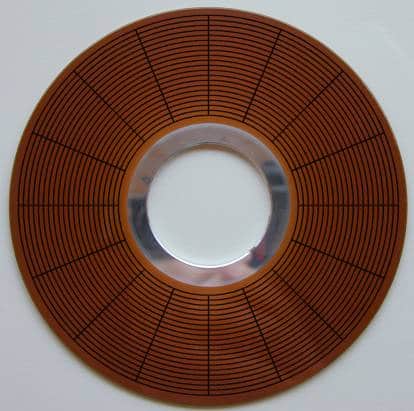Introduction
Today’s hard drives are formatted using a 512 byte sector, however in the near future most hard drives will be switching to a more modern 4kb sector (that is eight times as large, for those bad at math). While the 4kb sector will allow manufacturers to produce larger and more reliable hard drives, it is yet another reminder that we should be moving away from Microsoft’s aging Windows XP operating system.
Background on Hard Drives
A hard drive is the only part in a computer that uses moving parts (save for fans). Inside a hard drive are spinning discs that hold data using magnetic fields. Data is written and read from the platters using a movable arm (think record players, though it is not quite the same) that move between concentric tracks on the platters (again like a record players, except the tracks do not spiral inward). The picture above shows a hard drive platter with 20 concentric tracks, each divided into 16 sectors; up until this point, sectors have been 512 bytes in size (keep in mind the image above is has imaginary tracks and sectors drawn for demonstration purposes only; modern hard drives have thousands of tracks and millions of sectors).
The Problem with 512 Byte Sectors
The problem with the 512 byte sector is that it is outdated; it was created when hard drives were several hundred times smaller than current hard drives (can you remember hard drives measured in megabytes?). Each sector has a marker before it that stores error correcting codes (ECC) and a small space between it and the next sector. Modern hard drives have millions of sectors, so multiply the space ECC and gaps take up and that equals a lot of space. This is where the 4k sector comes in.
The 4kb Sector: Mostly Good With a Side of Bad
The new 4kb sector is eight times larger than the current 512k sector, and that means hard drives can potentially be more efficient at storing data to the tune of 7-11%. Fewer sectors mean less ECC code is needed and there are fewer gaps. In addition to increased storage efficiency there are also other benefits including better performance.
The problem with 4kb sector will be for those running older operating systems created before it was invented. The 512 byte sector was a large part of computer architecture for operating systems like Windows XP, which does not recognize the 4kb sector. Hard drive manufacturers are getting around this by programming 4kb sector hard drives to emulate 512 byte sectors. Unfortunately this has a negative performance impact to the tune of about 10% since the emulation causes significant overhead. It will cause delays in reading and writing data from the hard drive.
Conclusion
Hard drive manufacturers have hit the ceiling of what is capable with the 512 byte sector format. Remember, the 512 byte sector format was created when hard drives were measured in megabytes (a few thousand times smaller than today’s hard drives). The 4kb sector is an overdue advancement in hard drive technology and will improve hard drive storage efficiency and performance. For older operating systems hard-coded with the 512 byte sector it can pose a problem; while some 4kb sector hard drives will emulate 512 byte sectors for compatibility purposes there will be significant performance disadvantages due to the overhead involved in translating between the two. For the rest of us using 4kb sector-compatible operating systems (Vista, 7, Mac OSX, and modern Linux distros), the 4kb sector is nothing but good news.
Reference Articles:
Western Digital’s Advanced Format: The 4kb Sector Transition Begins

